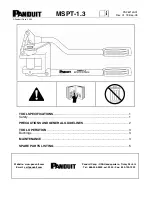
Pg. 13
BLL-95CU-PS
COLD WEATHER OPERATION
MILWAUKEE Li-Ion battery packs are designed to operate in temperatures below freezing. When
the battery pack is too cold, it may need to warm up before normal use. Put the battery on a tool
and use the tool in a light application. It may buzz for a short time until it warms up. When the
buzzing stops, use the tool normally.
To reduce the risk of fire, personal injury, and product damage due to a short circuit,
never immerse your tool, battery pack or charger in fluid or allow a fluid to flow inside them.
Corrosive or conductive fluids, such as seawater, certain industrial chemicals, and bleach or bleach
containing products, etc., can cause a short circuit.
MAINTENANCE AND STORAGE
Do not expose your battery pack or cordless tools to water or rain, or allow them to get wet. This
could damage the tool and battery pack. Do not use oil or solvents to clean or lubricate your
battery pack. The plastic casing will become brittle and crack, causing a risk of injury. Store battery
packs at room temperature away from moisture. Do not store in damp locations where corrosion
of terminals may occur. As with other battery pack types, permanent capacity loss can result if the
pack is stored for long periods of time at high temperatures (over 120° F). MILWAUKEE Li-Ion
battery packs maintain their charge during storage longer than other battery pack types. After
about a year of storage, charge the pack as normal.
TRANSPORT
Personal transport of Li-Ion battery packs is allowed when done in accordance with these
warnings and instructions. The proper classification, packaging, labeling, marking, and
documentation requirements for shipping Li-Ion batteries is dependent upon whether the
particular batteries is dependent upon whether the particular batteries are rated greater than or
less than 100 Wh. Generally, Li-Ion batteries rated 100 Wh or less are excepted from certain Class
9 DG requirements. Always check compliance of Li-Ion battery consignments against the current
regulations governing the chosen mode of transport. When in doubt, contact the carrier or other
trained Dangerous Goods professional to confirm acceptability. Li-Ion packs are shipped under
classification UN 3480 (battery only) or UN 3481 (batteries contained in or packed with equipment).
To reduce the risk of injury or explosion, never burn or incinerate a battery pack
even if it is damaged, dead, or completely discharged. When burned, toxic fumes and materials are
created.
DISPOSING OF MILWAUKEE LI-ION BATTERY PACKS
MILWAUKEE Li-Ion battery packs are more environmentally friendly than some other types of
power tool battery packs (e.g., nickel-cadmium). Always dispose of your battery pack according to
federal, state, and local regulations. Contact a recycling agency in your area for recycling locations.
Even discharged battery packs contain some energy. Before disposing, use electrical tape to cover
the terminals to prevent the battery pack from shorting, which could cause a fire or explosion.
RBRC BATTERY RECYCLING SEALS
The RBRC™ Battery Recycling Seals (see Symbology) on your tool battery packs indicate that
MILWAUKEE has arranged for the recycling of that battery pack with the Rechargeable Battery
Recycling Corporation (RBRC). At the end of your battery pack‘s useful life, return the battery pack
to a MILWAUKEE Branch Office/Service Center or the participating retailer nearest you. For more
information, visit the RBRC web site at www.rbrc.org.
Summary of Contents for UtilPro BLL-95CU-PS
Page 20: ...Pg 20 BLL 95CU PS Notes Notes ...
Page 21: ...Pg 21 BLL 95CU PS Notes ...
Page 22: ...Pg 22 BLL 95CU PS Notes ...
Page 23: ...Pg 23 BLL 95CU PS Notes ...










































